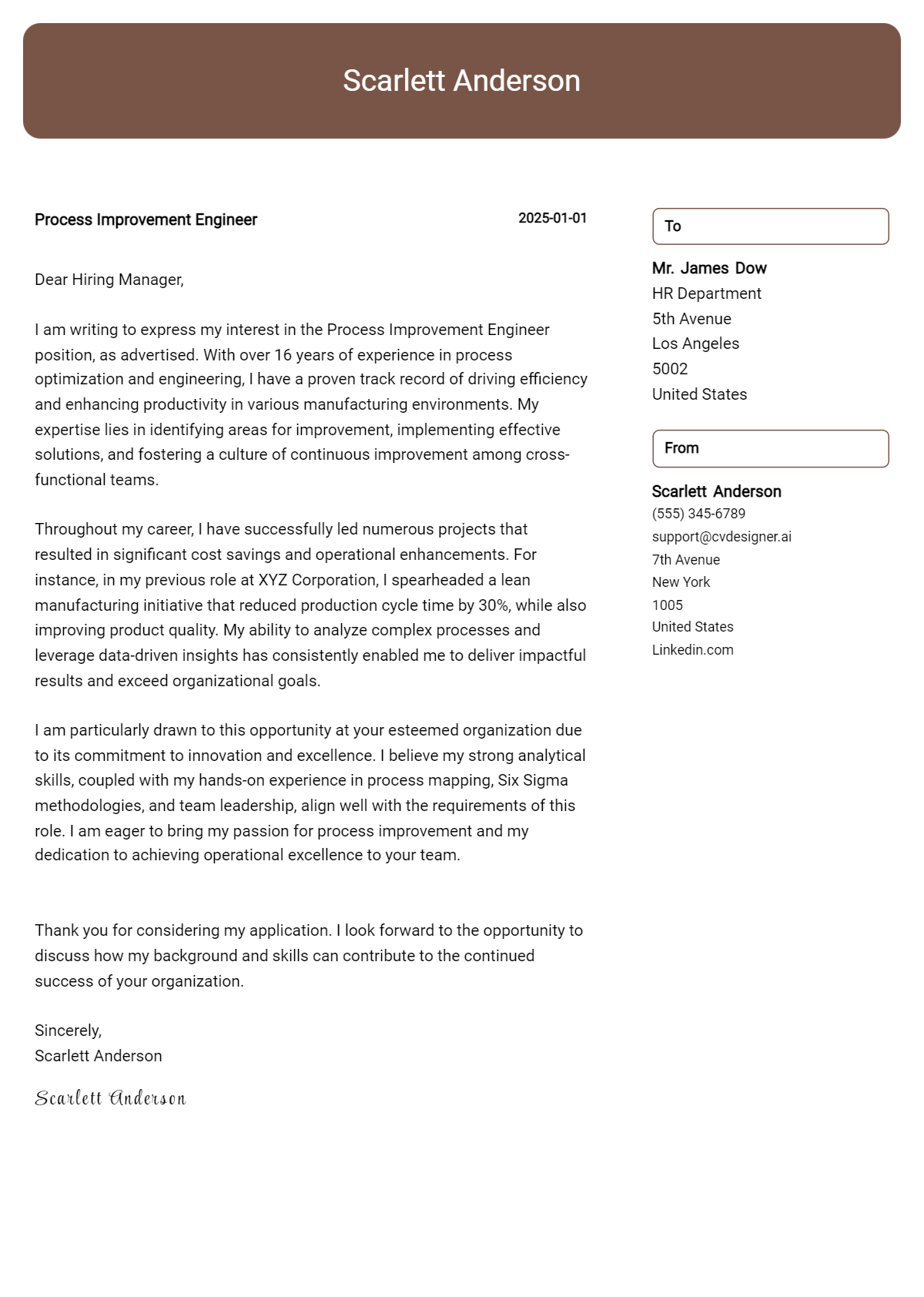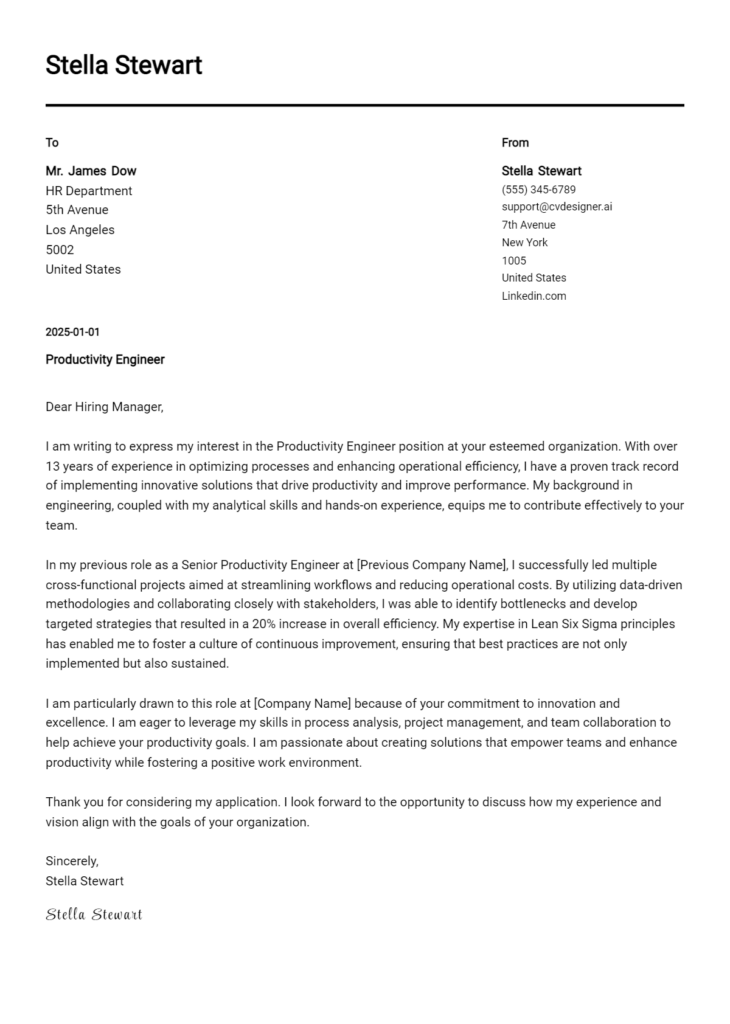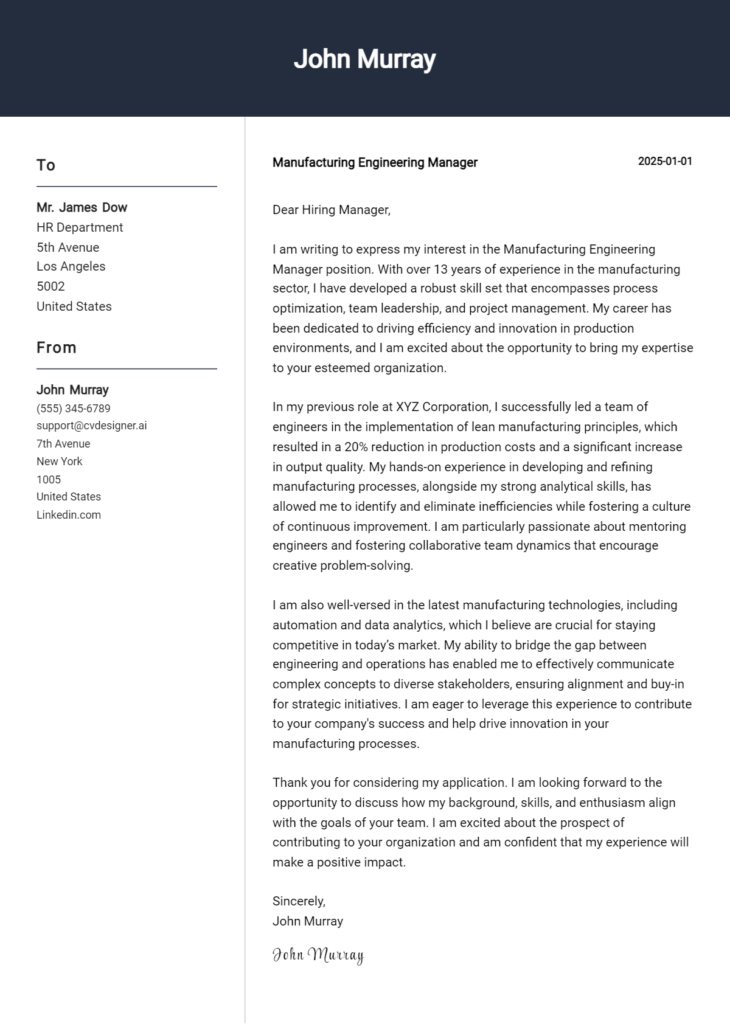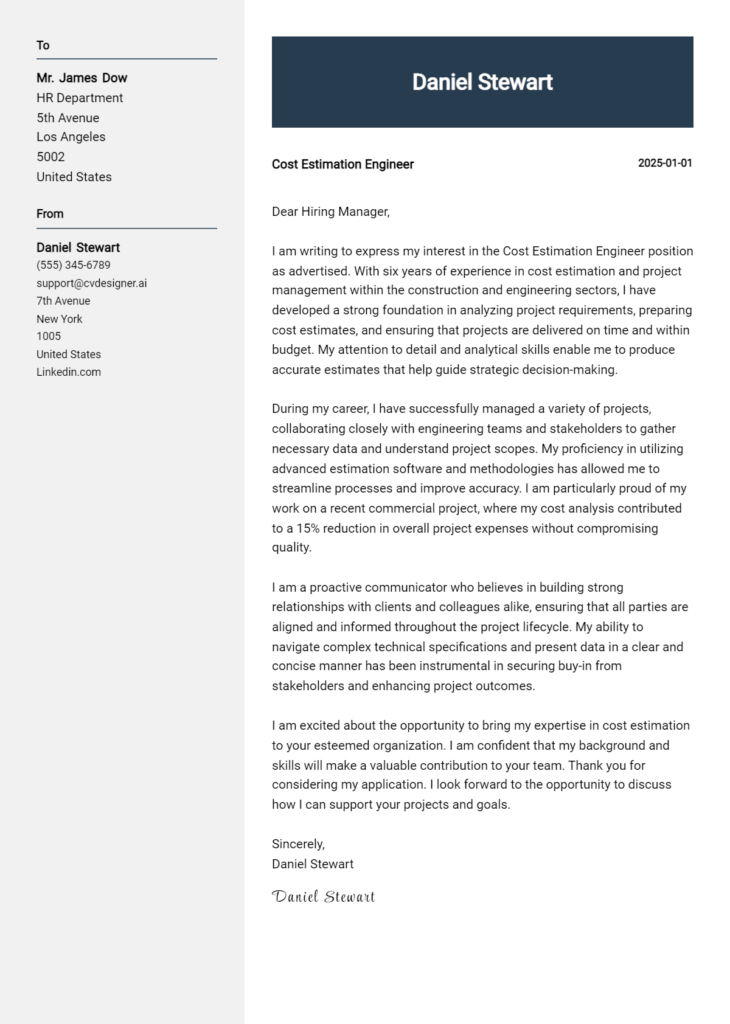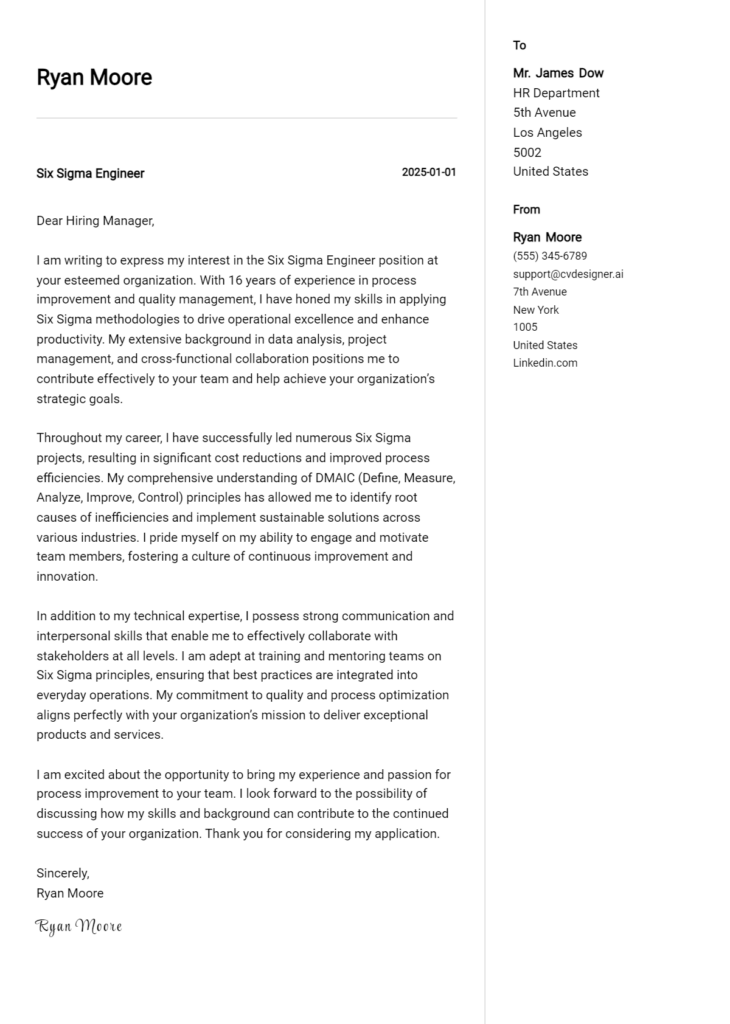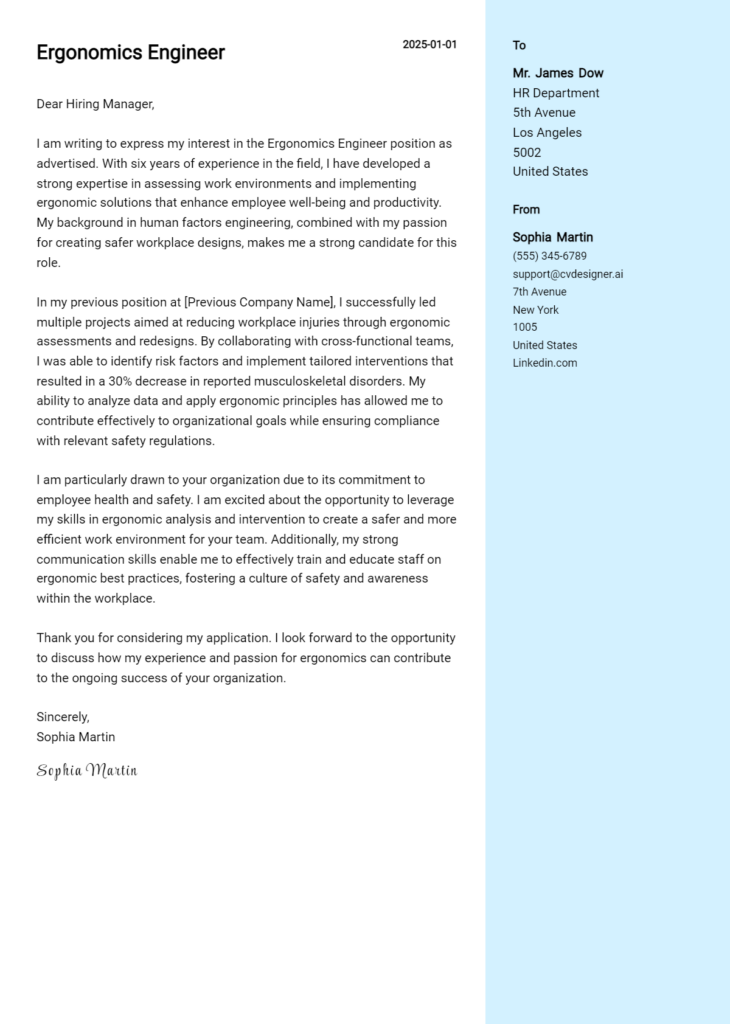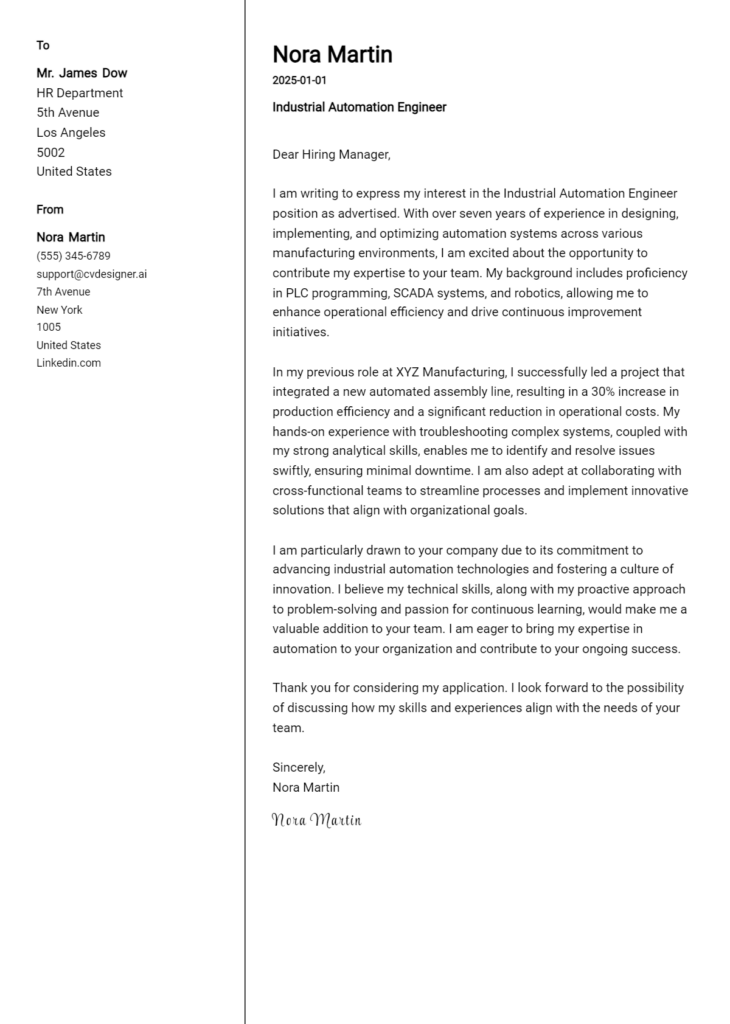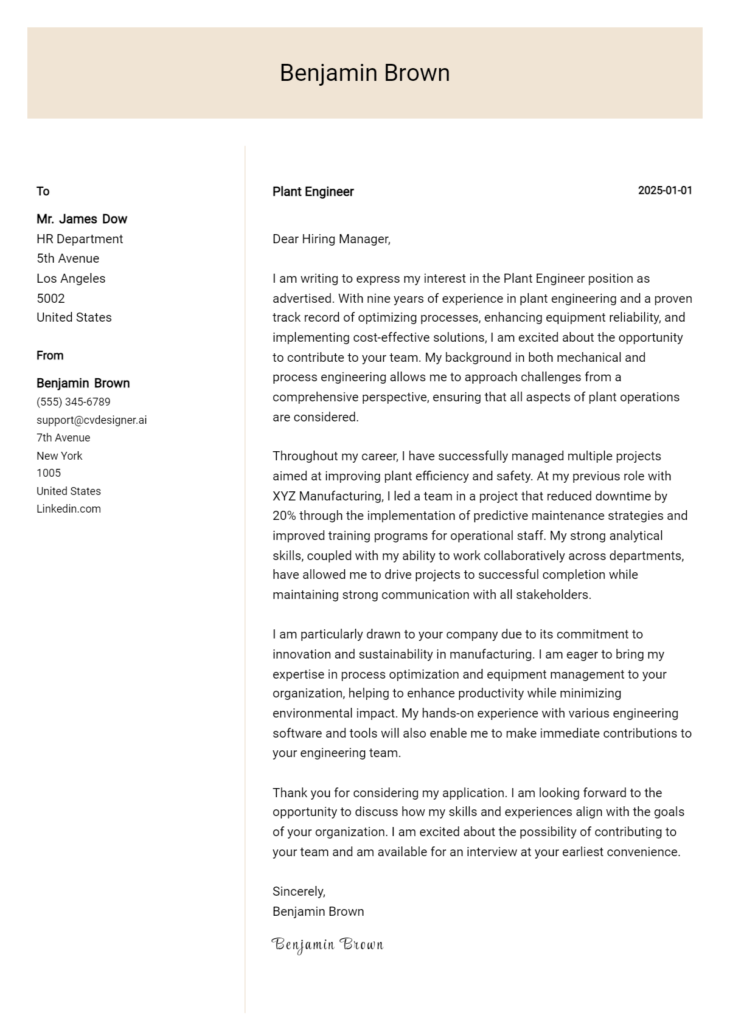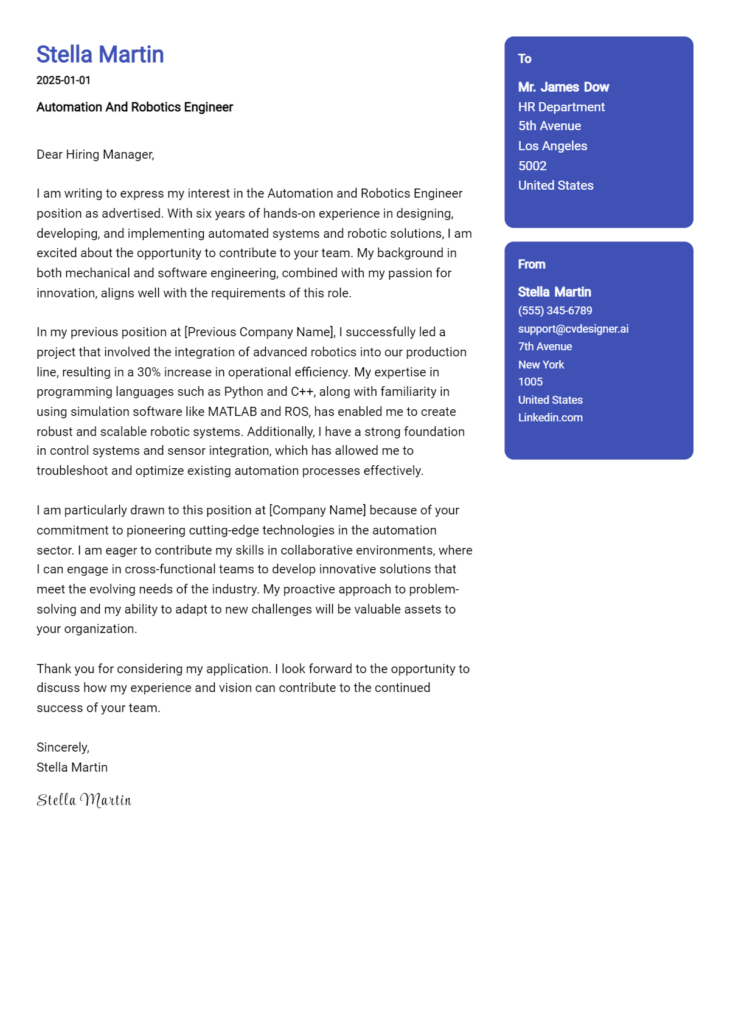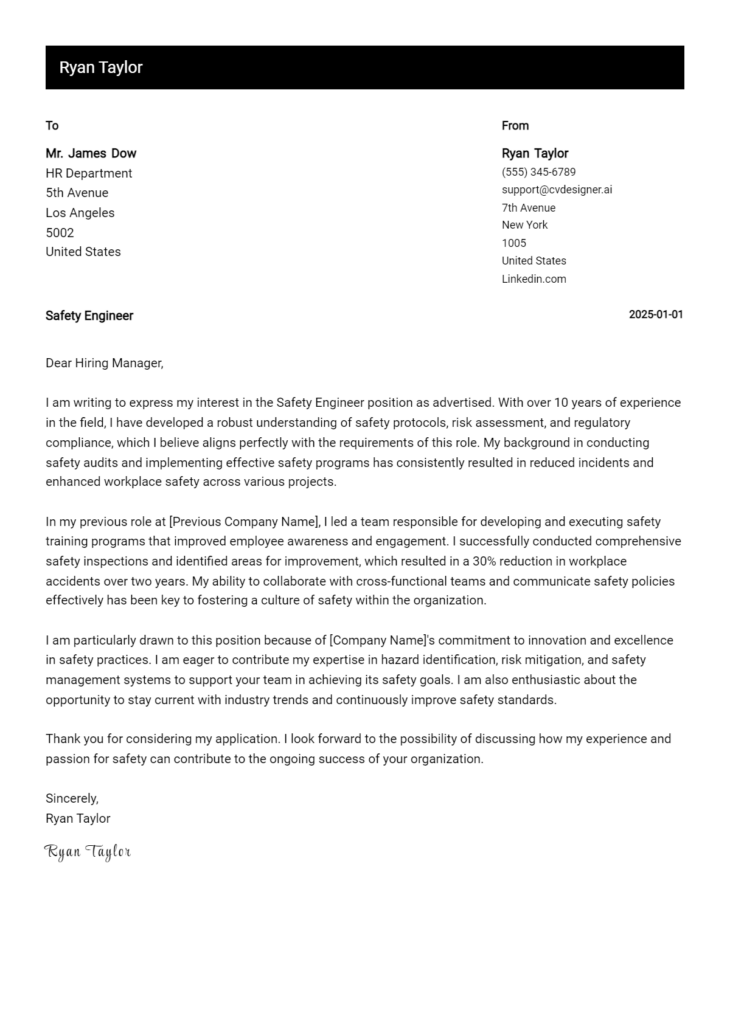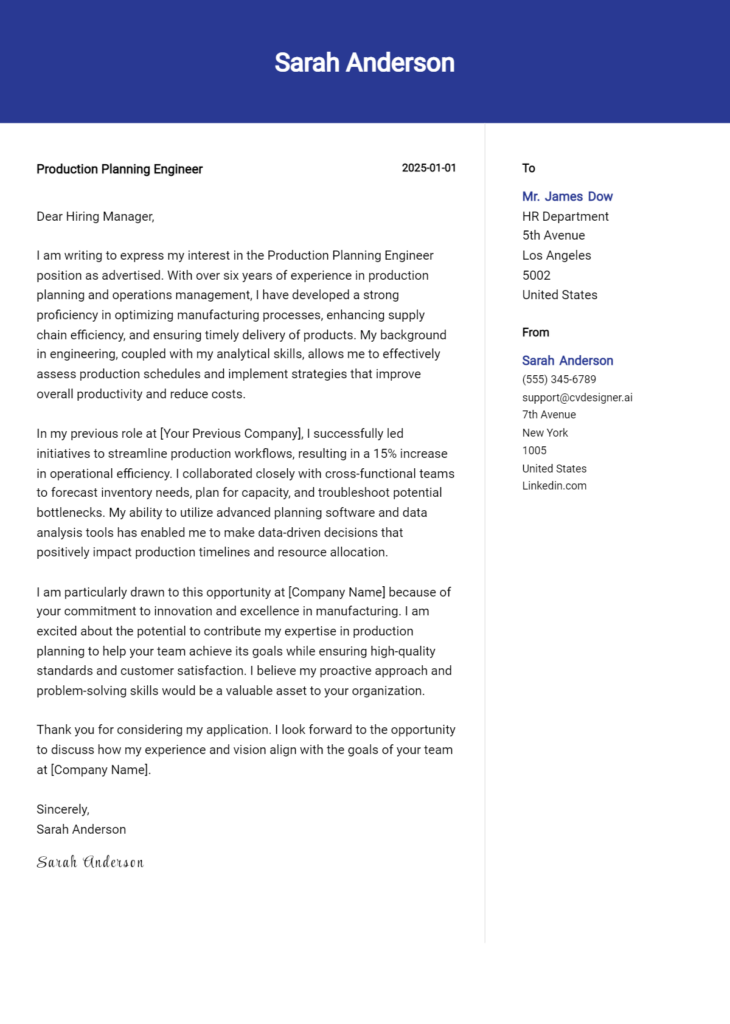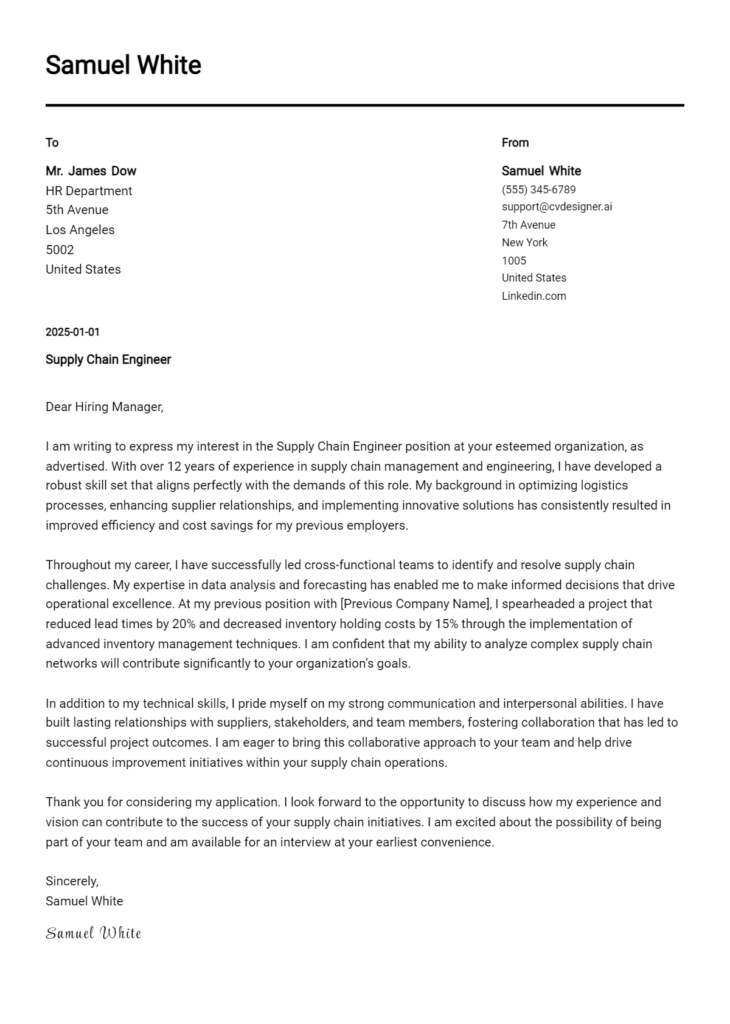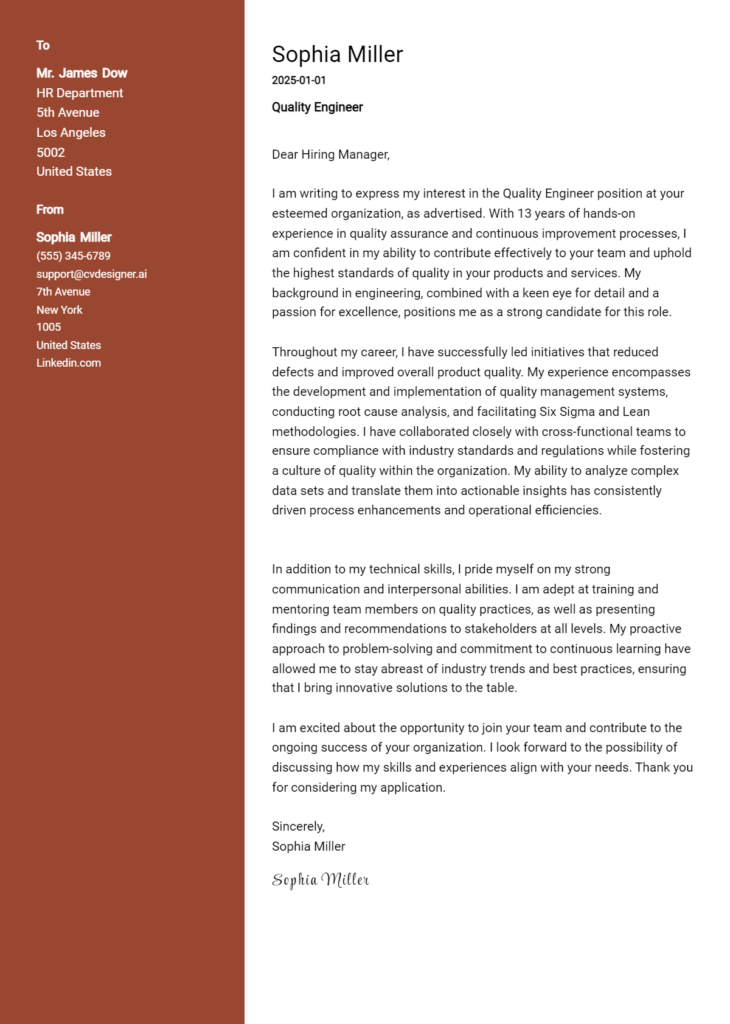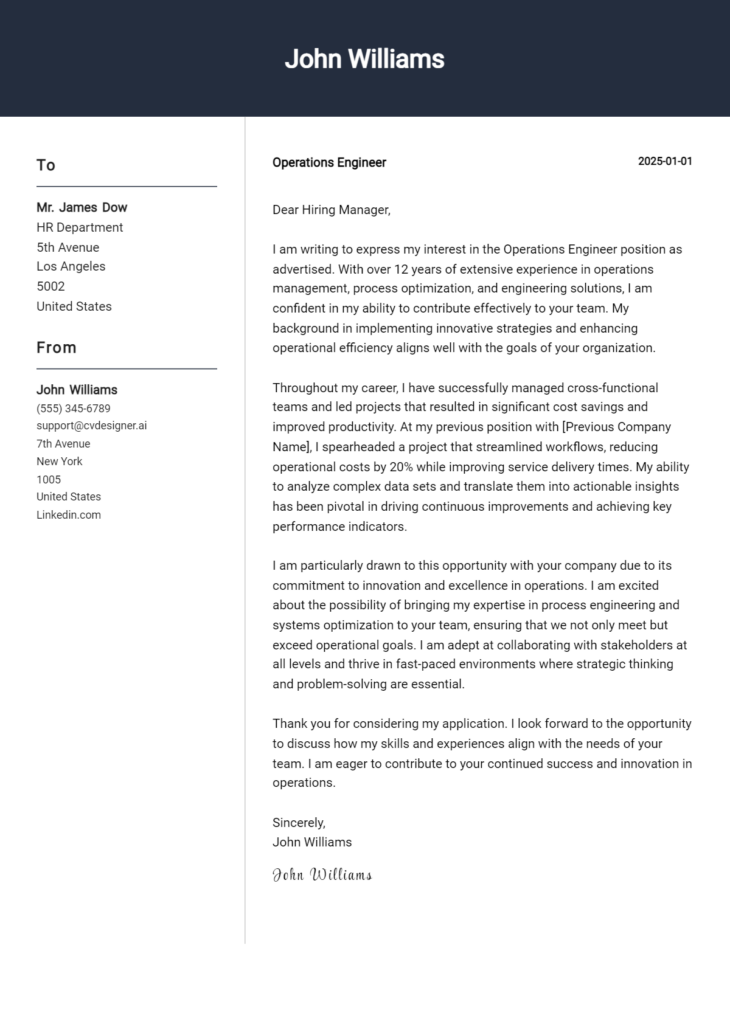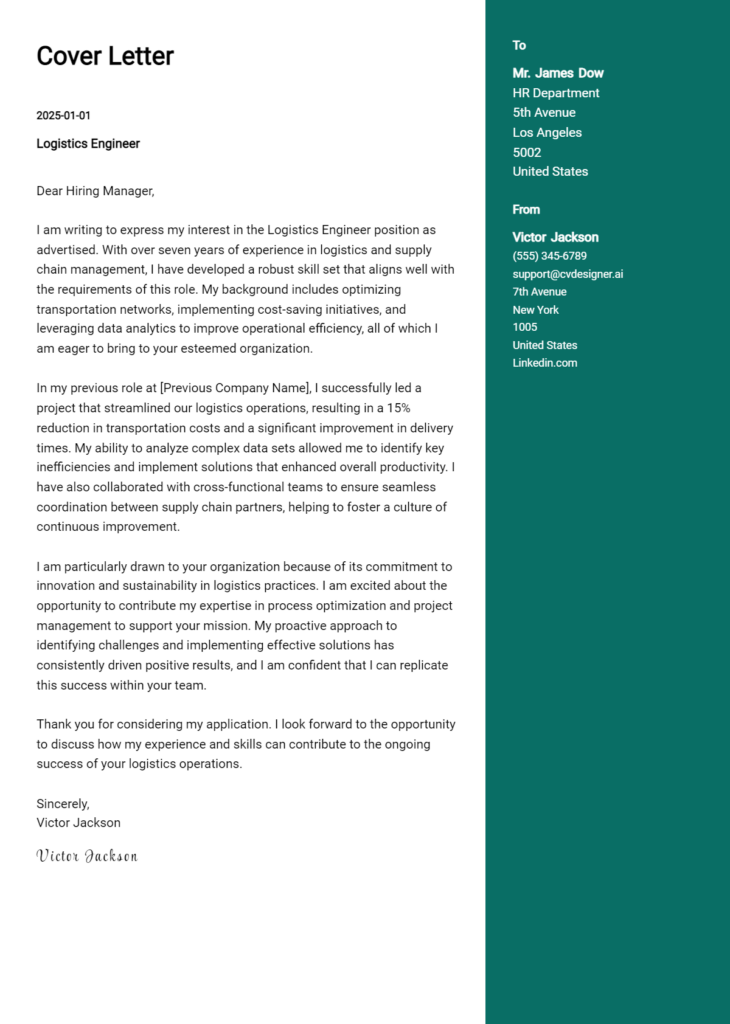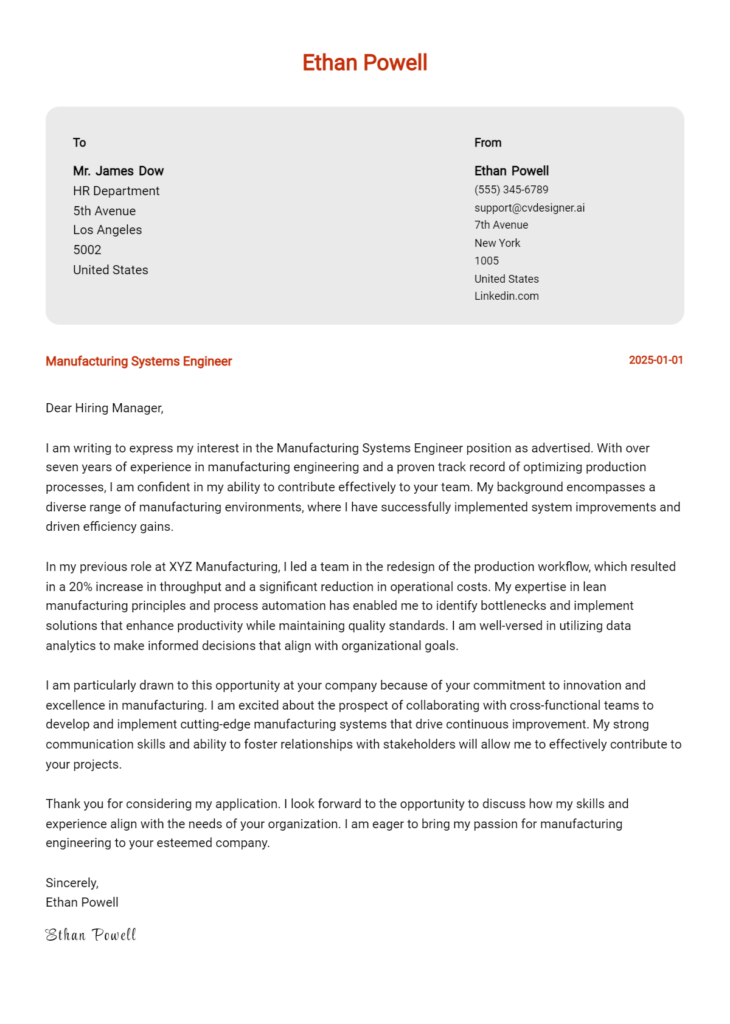Process Improvement Engineer Cover Letter Examples
Explore additional Process Improvement Engineer cover letter samples and guides and see what works for your level of experience or role.
How to Format a Process Improvement Engineer Cover Letter
Crafting a well-structured cover letter is essential for a Process Improvement Engineer, as it not only showcases your qualifications but also reflects your ability to streamline processes and enhance efficiency. The format you choose can convey your analytical skills and attention to detail—crucial traits for success in this role. A thoughtfully organized cover letter captures the hiring manager's attention and sets the tone for your application, demonstrating your commitment to quality and precision.
In this guide, we’ll outline the key components of an effective cover letter, providing insights and examples specific to the field of process improvement.
We’ll focus on the essential components of a professional cover letter, including:
- Cover Letter Header
- Cover Letter Greeting
- Cover Letter Introduction
- Cover Letter Body
- Cover Letter Closing
Each section serves a critical purpose in showcasing your qualifications and professionalism. Let’s delve into each part and explore how to make your cover letter stand out in the competitive landscape of process improvement engineering.
Importance of the Cover Letter Header for a Process Improvement Engineer
The header of a cover letter is crucial as it sets the tone for the entire document and provides essential information about the applicant. For a Process Improvement Engineer, clarity and professionalism in the header reflect attention to detail, which is a vital quality in this role. The header should include your contact information, the date, and the recipient's details, ensuring that the letter is easy to navigate and presents a polished image. A well-structured header not only makes a strong first impression but also facilitates clear communication.
Strong Example
John Doe 123 Main Street City, State, Zip Code Email: johndoe@email.com Phone: (123) 456-7890 [Date] Hiring Manager Company Name 456 Business Rd. City, State, Zip Code
Weak Example
John johndoe@email.com [Date] Company
The Importance of the Cover Letter Greeting
The greeting of your cover letter is not just a formality; it sets the tone for the entire document and serves as your first impression on the hiring manager. A well-crafted greeting demonstrates professionalism and a personal touch, showing that you have taken the time to address the recipient directly. This small yet significant detail can differentiate you from other candidates who may resort to generic salutations. Researching the hiring manager's name can enhance your greeting, conveying your genuine interest in the position and the company. To make a strong impact, it's crucial to avoid vague and impersonal greetings that do not engage the reader.
Strong Greeting Example
Dear Mr. Johnson,
Weak Greeting Example
To Whom It May Concern,
The Importance of a Strong Cover Letter Introduction for a Process Improvement Engineer
A well-crafted cover letter introduction is crucial for a Process Improvement Engineer as it sets the tone for the entire application. This introductory paragraph serves as the first opportunity to capture the hiring manager's attention, convey genuine interest in the role, and briefly highlight the candidate’s relevant skills or achievements. An impactful introduction not only piques interest but also encourages the reader to continue exploring the applicant’s qualifications. Below are examples of strong and weak introductions to help illustrate the difference.
Strong Example:
Dear [Hiring Manager's Name], I am excited to apply for the Process Improvement Engineer position at [Company Name], as I am passionate about optimizing workflows and enhancing productivity in engineering processes. With over five years of experience in Lean Six Sigma methodologies, I successfully led a project that reduced production waste by 30%, resulting in significant cost savings. I am eager to bring my expertise in process analysis and continuous improvement to your innovative team.
Weak Example:
To whom it may concern, I am writing to express my interest in the Process Improvement Engineer job. I have some experience in engineering and think I could do well in this role. I have worked on a few projects, but I’m not sure how relevant they are to your needs.
Purpose of the Cover Letter Body for a Process Improvement Engineer
The body of a cover letter for a Process Improvement Engineer serves as a crucial platform for the candidate to articulate their relevant skills, experiences, and the unique value they can bring to the organization. This section should effectively highlight specific projects or accomplishments that demonstrate their expertise in process optimization, data analysis, and project management. By providing concrete examples of past successes—such as reducing production waste by a specific percentage or improving efficiency in a key process—the candidate can create a compelling narrative that aligns their capabilities with the potential employer's needs.
Strong Example
In my previous role at XYZ Corporation, I led a cross-functional team to implement a Lean Six Sigma project that resulted in a 30% reduction in cycle time for our manufacturing process. By analyzing workflow data and identifying bottlenecks, we streamlined operations, which not only enhanced productivity but also improved employee satisfaction. Additionally, I spearheaded a continuous improvement initiative that saved the company over $250,000 annually by optimizing inventory management practices. My ability to leverage data-driven insights and foster collaboration among teams positions me to contribute effectively to your organization’s goals.
Weak Example
I have worked in process improvement for a few years and have done some projects that made things better. I believe I can help your company too. I like working with teams and am familiar with Lean practices. I am hoping to bring my skills to your company and help with process improvements.
Importance of the Cover Letter Closing for a Process Improvement Engineer
The closing of a cover letter is a critical component, especially for a Process Improvement Engineer. It serves as the final opportunity to summarize your qualifications succinctly, reiterate your enthusiasm for the position, and encourage the hiring manager to take the next steps, such as reviewing your resume or scheduling an interview. A strong closing leaves a lasting impression, while a weak one may diminish the overall effectiveness of your application.
Strong Example
In conclusion, my extensive experience in process optimization and my commitment to continuous improvement align perfectly with the goals of your team at [Company Name]. I am genuinely excited about the opportunity to contribute my skills to enhance operational efficiency and drive innovation. I look forward to the possibility of discussing how my background can support your objectives. Thank you for considering my application, and I hope to speak with you soon to explore this opportunity further.
Weak Example
Thanks for reading my letter. I think I would be a good fit for the Process Improvement Engineer role. Please look at my resume when you have time. I hope to hear back from you soon.
These tips will assist candidates in crafting an effective cover letter for a Process Improvement Engineer position. A well-written cover letter can set you apart from other applicants by showcasing your technical skills, problem-solving abilities, familiarity with the Software Development Life Cycle (SDLC), teamwork experiences, and your passion for continuous learning. By highlighting these aspects, you can demonstrate your suitability for the role and your commitment to enhancing processes within an organization.
Tips for Writing a Cover Letter for a Process Improvement Engineer
Highlight Technical Skills: Clearly outline your technical competencies relevant to process improvement, such as proficiency in Lean Six Sigma methodologies, data analysis tools, or process mapping software. Mention specific projects where these skills contributed to measurable improvements, which can help illustrate your capabilities to potential employers.
Emphasize Problem-Solving Abilities: Employers value engineers who can identify issues and implement effective solutions. Share examples of challenges you've faced in previous roles and the strategies you employed to overcome them. Use metrics to quantify the impact of your solutions, whether it be cost savings, time reductions, or quality enhancements.
Showcase SDLC Knowledge: If applicable, discuss your understanding of the Software Development Life Cycle and how it relates to process improvement. Highlight any experience you have in optimizing processes within the SDLC, such as improving requirements gathering or enhancing testing procedures, to demonstrate your relevance to tech-driven companies.
Demonstrate Teamwork Experience: Process improvement often requires collaboration across various departments. Illustrate your experience working in teams, especially on cross-functional projects. Discuss how you contributed to team dynamics and how your collaborative efforts led to successful outcomes, emphasizing your ability to communicate effectively with diverse groups.
Convey a Passion for Continuous Learning: The field of process improvement is always evolving, and employers seek candidates who are committed to growth. Mention any relevant certifications, training programs, or workshops you have completed. Additionally, express your enthusiasm for staying updated on industry trends and seeking new knowledge to enhance your skills.
For a well-structured cover letter, consider utilizing cover letter templates or a cover letter builder to create a polished document that effectively showcases your qualifications.
Common Mistakes to Avoid in a Process Improvement Engineer Cover Letter
Avoiding common mistakes in your cover letter is crucial for standing out in the competitive field of process improvement engineering. A well-crafted cover letter not only showcases your skills but also reflects your attention to detail and professionalism. Here are some frequent pitfalls to watch out for:
Generic Content: Sending a one-size-fits-all cover letter can diminish your chances. Tailor your letter for the specific position by referencing the job description and company values.
Lack of Specific Examples: Failing to provide concrete examples of your achievements can weaken your narrative. Use quantifiable results from previous roles to demonstrate your impact on process improvements.
Overly Technical Language: While technical skills are essential, using jargon can alienate hiring managers. Aim for clear, concise language that highlights your engineering expertise without overwhelming the reader.
Ignoring the Employer's Needs: Focusing solely on your qualifications rather than how you can meet the employer's needs can be detrimental. Research the company and align your skills with their specific challenges.
Poor Formatting: Neglecting proper formatting can make your cover letter difficult to read. Follow a structured cover letter format to enhance readability and presentation.
Typos and Grammatical Errors: Simple mistakes can convey a lack of attention to detail. Always proofread your letter or use tools to catch errors before submission.
Failing to Include a Call to Action: Not inviting the employer to discuss your application further can be a missed opportunity. Conclude with a strong call to action, expressing your eagerness to discuss your fit for the role.
For further inspiration, check out some cover letter examples that can guide you in creating a compelling narrative. By avoiding these common mistakes, you can enhance your chances of landing an interview as a Process Improvement Engineer.
Cover Letter FAQs for Process Improvement Engineer
How should I structure my cover letter for a Process Improvement Engineer position?
Your cover letter should begin with a strong introduction, stating the position you are applying for and briefly mentioning your relevant experience. Follow with a body section that highlights specific skills and accomplishments related to process improvement, such as successful projects or methodologies (like Lean or Six Sigma) you have implemented. Use bullet points if necessary to make key achievements stand out. Conclude with a strong closing paragraph that reiterates your interest in the role and invites the employer to discuss your application further. Make sure to keep the tone professional yet personable, reflecting your passion for process improvement.
What specific skills should I highlight in my cover letter?
When applying for a Process Improvement Engineer role, emphasize skills such as data analysis, project management, and proficiency in process improvement methodologies like Lean, Six Sigma, or Kaizen. Additionally, highlight your ability to work collaboratively in cross-functional teams, your analytical thinking, and your problem-solving abilities. If you have experience with specific tools or software (such as Minitab or Visio), mention these as well. Tailor your skills to align with the job description, demonstrating that you possess the qualifications the employer is seeking and showing how these skills have led to tangible improvements in previous positions.
Should I include specific metrics or outcomes in my cover letter?
Absolutely! Including specific metrics or outcomes in your cover letter can significantly enhance its impact. Quantifying your achievements provides concrete evidence of your capabilities and demonstrates your effectiveness in previous roles. For instance, you might mention how a process improvement project led to a 20% reduction in waste or improved cycle times by 30%. These figures not only catch the hiring manager's attention but also clearly illustrate your success in delivering measurable results. Be sure to relate these metrics directly to the skills and methodologies relevant to the Process Improvement Engineer position you are applying for.
How long should my cover letter be?
Your cover letter should ideally be one page long, consisting of three to four paragraphs. Aim for a concise format that allows you to express your qualifications and enthusiasm without overwhelming the reader. Each paragraph should serve a specific purpose: the introduction captures attention, the body highlights your relevant experience and achievements, and the conclusion reinforces your interest in the position while prompting a follow-up. Remember to keep the language clear and focused, ensuring that every sentence adds value. A well-structured, succinct cover letter is more likely to leave a positive impression on hiring managers.
Build your Cover Letter in minutes
Use an AI-powered cover letter builder and have your letter done in 5 minutes. Just select your template and our software will guide you through the process.

